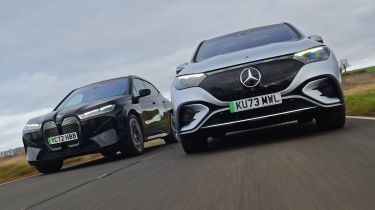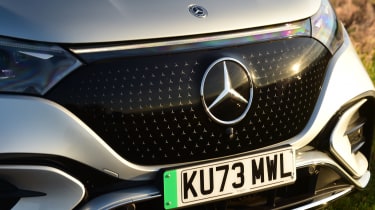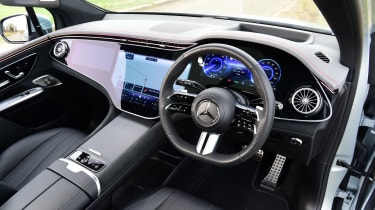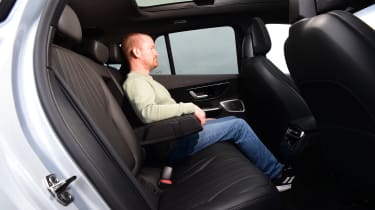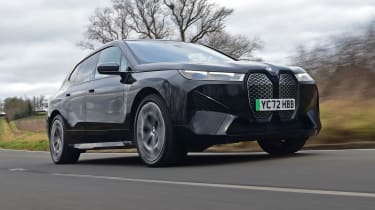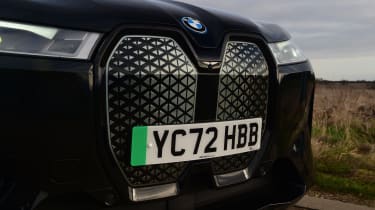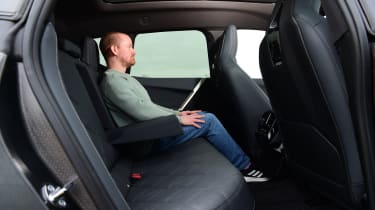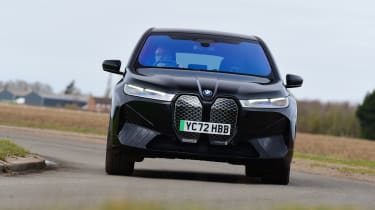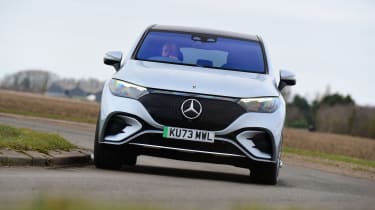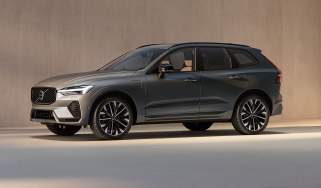BMW iX vs Mercedes EQE SUV 2024 twin test: which is the best posh electric SUV?
Luxury electric 4x4s go head to head as the new Mercedes EQE SUV takes on the BMW iX
Mercedes and BMW have been natural rivals for longer than most of us can remember. As two of Germany’s big three premium brands, they have competed across a number of segments over the years.
Whether it’s in the compact executive class, super-saloons with the firm’s M and AMG badges, or attempting to earn conquest sales among younger customers with small hatchbacks such as the 1 Series and A-Class, there’s always a pair of adversaries looking for a fight.
Historically, the larger the car, the more likely a Mercedes victory; the Stuttgart brand has always excelled at luxury. But with the segment moving towards electrification, does that still ring true?
We’re pitting the marques against each other for this latest battle in the class for high-end luxury electric SUVs that break the six-figure barrier.
Mercedes offers up the new EQE SUV, while in BMW’s corner is the iX, a car that defeated Audi’s e-tron — since revised as the Q8 e-tron — in an Auto Express road test a couple of years ago. So can Mercedes still hold the luxury crown, or will the iX remain undefeated against newer German competition?
| Mercedes EQE 500 SUV AMG Line Premium Plus | BMW iX xDrive50 M Sport | |
| Price: | £121,760 | £104,285 |
| Powertrain: | 2x e-motors, 91kWh battery, 402bhp, four-wheel drive | 2x e-motors, 105kWh battery, 516bhp, four-wheel drive |
| 0-62mph: | 4.9 seconds | 4.6 seconds |
| Test efficiency: | 2.4mi/kWh | 2.7mi/kWh |
| Max charging rate: | 170kW | 200kW |
| 10-80%: | 31 minutes | 34 minutes |
Mercedes EQE SUV
It really hammers home the premium positioning of the Mercedes EV line-up that the EQE 500 SUV, tested here in £121,760 AMG Line Premium Plus trim, sits below the even larger and pricier EQS SUV.
Tech highlights
The EQE SUV was designed as a ground-up pure-electric vehicle, and is the fourth model to use the brand’s modular EV architecture, after the EQS and EQE saloons, as well as the EQS SUV. All four cars have a distinctive look that has been dictated by aerodynamics, which is why the tall, large EQE SUV is still able to return a low coefficient of drag of 0.25Cd.
Used - available now

2023 Land Rover
Range Rover Evoque
39,714 milesAutomaticPetrol1.5L
Cash £27,986
2022 Land Rover
Range Rover Sport
46,970 milesAutomaticPetrol2.0L
Cash £34,787
2022 Audi
A3 Sportback
68,045 milesManualDiesel2.0L
Cash £15,787
2022 Volkswagen
T-Roc
42,783 milesAutomaticPetrol1.5L
Cash £18,787Energy is supplied by a 91kWh battery that’s mounted under the floor, which feeds a pair of electric motors, one on each axle. The resulting 402bhp and thumping 858Nm of torque look very healthy on paper, but the EQE weighs 2,560kg. To boost efficiency, the front motor can be decoupled in certain conditions, while energy can be recovered via regenerative braking. The driver has four levels to choose from (including full coasting with no regen) plus an adaptive setting dictated by the car based on surrounding traffic and the road layout.
Due to wheel sizes and other fitted equipment, the AMG Line Premium Plus here has a WLTP-certified range of 307 miles – the lower-spec AMG Line Premium can cover an additional 17 miles.
The EQE SUV is fitted with air suspension featuring a four-link set-up at the front and a multi-link configuration at the rear.
Safety: The EQE SUV was awarded a five-star Euro NCAP rating when it was assessed in 2023. Results were strong across the board, with its Child Occupant protection score of 90 per cent being the highest of any car tested last year.
On the road
For its size, the EQE SUV is easy to drive around town. It’s also a great cruiser at higher speeds, but it’s less impressive on twisty roads, and despite its slippery body shape, efficiency is poor.
Around town: Our EQE was fitted with four-wheel steering, and around town it’s absolutely brilliant. It slashes the turning circle from 12.3 metres without the extra 10 degrees of rear axle assistance to just 10.5 metres.
That means this near five metre-long SUV turns half a metre tighter than an A-Class hatch, or the same as the supermini-sized Jeep Avenger. However, the shine is taken off urban driving by the brakes, which feel a little grabby at parking speeds.
A & B-roads: On twistier roads, the EQE SUV comes unstuck. A car like this would never be the last word in driver involvement, but nicely weighted steering aside, the car feels lethargic in its responses. Performance is strong – 0-62mph takes just 4.9 seconds – but the throttle feels almost as lazy as the chassis, so it takes a firm press to encourage any sort of urgency.
Of more concern, given the performance, is that the brakes feel as if they’re struggling to bring the EQE SUV’s significant mass to a stop.
On the plus side, ride comfort is smooth for the most part, but the body isn’t as tightly controlled as it should be, which results in a little side-to-side rocking across uneven road surfaces.
Motorway: Superb sound deadening, a smooth ride and strong stability make the EQE SUV a great long-distance motorway cruiser. For those who venture on motorways with higher speed limits than our own, the car’s ride height drops by up to 20mm at more than 75mph to help reduce drag.
Ownership
Slip behind the wheel of the EQE SUV, and you’re presented with a very imposing slab of dashboard. It’s unnaturally high at its upper level, which means that regardless of the height of our testers behind the wheel, we found ourselves jacking up the seat far higher than we might like just so that we could see out. This also offsets the otherwise impressive headroom up front – taller people will be drawing a fine line between visibility and space.
The cabin is dominated by the Hyperscreen infotainment array, which comes as standard on AMG Line Premium Plus models. With so much screen ahead, there’s not much space to make use of the sort of materials that mean older Mercedes cars feel so luxurious. The parts that can be touched, such as the Alcantara and wood panels on the lower part of the dash, still feel suitably posh.
A premium brand brings high expectations from its owners. Based on the results of our 2023 Driver Power customer satisfaction survey, Mercedes doesn’t quite live up to those demands, with the manufacturer taking a disappointing 25th out of 32 in the brand rankings. BMW fared a little better, but still not great, in 21st place.
Storage: A big cabin brings with it a wide range of very generous cubby options. Slide back the wooden panel below the central touchscreen and a huge bin in which to store a smartphone is revealed. It also houses space for a pair of cup-holders, part of a modular storage option that can be removed completely if you’d just prefer a big space.
There are USB-C ports everywhere: two in that main bin, two in the vast under-armrest space between the front seats, and two more on the large shelf beneath the centre console, which also features elastic strapping to hold items securely. There are two more USB-C sockets in the back, too. Elsewhere, the door pockets are large, but the glovebox is surprisingly modest.
Practicality
There's no faulting the space available inside the EQE SUV, both for passengers and for their things.
Rear Space: Headroom and legroom are excellent in the back of the EQE SUV, with vast reserves of space for tall adults in the outer rear seats. The wide cabin means it’s easy to sit three across the bench, even if that centre seat is a little more perched and not as soft as those to either side.
Boot: A 520-litre boot volume is very generous, and this can be bumped up to 580 litres if the rear occupants are willing to adopt a more upright seating position. The EQE SUV’s rear bumper is quite deep, so you need to be careful when loading items on board, but the three-way-split rear seat backs drop almost flat with the boot floor. In this position, the EQE offers up 1,675 litres of space. Neither car has a front boot.
What to buy?
Which engine and trim we’d choose
- Powertrain: The EQE 500 SUV is the middle of three powertrain options. The line-up starts with the 350; power drops to 284bhp and range is largely the same, with better efficiency balanced by a smaller 89kWh battery. At the top sits the 609bhp AMG EQE 53, which sprints from 0-62mph in 3.7 seconds.
- Trim: AMG Line Premium, Premium Plus and Business Class are the three trim levels paired with the 500 powertrain. There’s a £13,000 step between Premium and Plus (which is the same price as the Business Class) to justify the extra equipment offered.
- Our choice: For the four-wheel steering alone, we’d aim for AMG Line Premium Plus.
BMW iX
The BMW appears to be off to a strong start even before these cars have turned a wheel. At £104,285 (or £112,115 with the optional extras of our test car) it comfortably undercuts its rival on price. However, things aren’t so straightforward when finance costs are calculated.
Tech highlights
It doesn’t feel as though EVs have been around for that long, but BMW says the iX is already using the brand’s fifth-generation drivetrain tech. Here, that means a pair of electric motors that use no cobalt in their construction, and which are claimed to be 93 per cent efficient – far superior to any internal combustion engine. Combined, they make 516bhp and 765Nm of torque – enough to haul this 2,510kg SUV from 0-62mph in 4.6 seconds.
That weight is significant, because it means the iX weighs 50kg less than the EQE SUV, despite the fact that one of the heaviest components of an EV, the battery, has a capacity of 105.2kWh – that’s 14.2kWh more than its rival.
As with the Mercedes, the iX makes use of a proprietary architecture that features on a variety of cars. The CLAR structure is partly responsible for the weight saving; there’s extensive use of carbon fibre in the car’s structure, a material that BMW has proudly left exposed when you open the doors.
Even though it’s an SUV, BMW has still given the iX a suspension layout which encourages enthusiastic driving; the iX uses a motorsport-style double-wishbone arrangement at the front, with a multi-link set-up at the rear.
Safety: Euro NCAP assessed the iX in 2022, and it achieved a five-star rating. Scores were solid across the board, with its highest rating coming in the Adult Occupant category, where the car’s eight airbags helped it achieve 91 per cent.
On the road
Low-speed manoeuvres aside, the iX is better to drive than the Mercedes in almost every area.
Around town: It takes little time to dial yourself into the BMW’s steering. Compared with the Mercedes, the rack feels much more sensitive and almost a little too light. As with the EQE, four-wheel steering is fitted, but it isn’t as effective as its rival’s.
Refinement is outstanding though; at low speeds, the iX is eerily quiet. However, there is a very slight fidget to the ride at low speeds, which isn’t present in the Mercedes.
A & B-roads: The greatest gulf separating these two cars’ abilities comes with their chassis. Find a set of corners, and the BMW is infinitely more agile and responsive than its rival. Initially you may question whether this is an illusion caused by the lighter, faster steering, but put that to one side and the iX reveals itself to be more responsive yet secure, better balanced yet grippier, and more fun while being even more composed.
The iX can smother bumps which cause the EQE SUV to rock from side to side, and it feels like a fundamentally more sophisticated drive.
There’s little to separate the two in performance, but the BMW has a narrow edge and its throttle response is more lively, further boosting the impression that the iX is a lighter car.
Motorway: Any fidget caused by those large 22-inch wheels is long gone at motorway speeds, and as with the EQE SUV, the iX is exceptionally capable. The ride is superb, and that low centre of gravity gives excellent stability. The throttle response makes long inclines and overtakes feel effortless. It’s also ever so slightly quieter than its rival, courtesy of less wind rustle.
Ownership
There’s a very different approach to interior design between the Mercedes and BMW. The former seems to have followed a traditional formula that’s shared with previous models, but with the latest tech shoehorned to fit, while the iX feels like the design has stepped forward a generation or two from its ICE-powered rangemates.
The colours, materials and overall design are futuristic yet superbly finished, but the inclusion of the iDrive click wheel for the infotainment system shows that some thought has been given to intuitive ergonomics. It’s a shame that the dashboard lacks physical climate controls, though.
In stark contrast to the EQE SUV, the iX’s window line is very low, so you get a fantastic view out, both ahead and to the side. There’s plenty of adjustment for the driving position, although the oddly shaped steering wheel won’t be to everyone’s taste. Some testers were pleased that it isn’t needlessly thick, as it is on the brand’s M-badged performance cars, though.
If you intend to make use of public rapid chargers often, then BMW’s Flex card will come in handy. For the first year, it offers free subscription to Ionity and BP Pulse chargepoints and access to discounted charging rates. The Mercedes Me app offers similar benefits, and can also be connected to certain smart home features, enabling drivers to check if they have left house lights on or doors unlocked from their car.
Storage: Large front door pockets are split into two sections; the front is designed to hold a large bottle, while there’s plenty of room for more general storage behind. The glovebox is small, but the central bin between the front seats is very deep.
There’s a large open space between the front seats, which adds to the cabin’s open feel, but it doesn’t help storage. There are a couple of cup-holders in the centre console, though.
Practicality
The iX is almost a match for the EQE SUV in terms of both interior and boot space. In other words, it’s enormous inside.
REAR Space: A flat floor and those large side windows make the iX feel very airy and spacious inside. The outer rear seats are comfortable, and the middle seat is slightly more forgiving than the one in the Mercedes. Big doors and lots of space mean that installing a child seat in either car is easy; the ISOFIX mounting points are hidden behind a leather panel in the iX, and some plastic clips in the EQE SUV.
Boot: While the iX’s 500-litre boot just falls short of the EQE SUV’s for outright volume, a shallower bumper makes it easier to load bulky items into the BMW. The rear seats can be folded using buttons in the boot area, and they sit almost level with the boot floor. Like this, the volume is larger than its rival’s, at 1,750 litres.
What to buy?
Which engine and trim we’d choose
- Powertrains: The iX is offered with a choice of three powertrains. The base xDrive40 starts at £70,985, but its battery is much smaller than the xDrive50’s, at 74.1kWh instead of 105.2kWh, and its official range is 251 miles. Its 322bhp is down too, but that will still be plenty for most drivers. The top-spec £124,605 M60 sacrifices range and comfort for even stronger performance.
- Trim: The xDrive50 is only available in M Sport guise. This means it gets more imposing bumpers than the Sport, plus privacy glass and a different design of alloy wheels.
- Our choice: For the extra range it offers, the xDrive50 is the pick of the line-up.
Results
Which car comes out on top?
Winner: BMW iX
Almost three years on from its launch, the competition is still yet to catch up with the BMW iX. It’s not just impressive as an SUV, but as a luxury car in general; ride comfort, refinement, interior space, tech and build quality are all brilliant.
Also consider that the iX feels so much more agile and is more efficient than its rival here, its range is great and charging speeds are rapid, and it’s incredibly hard to fault. If you’re able to overlook its challenging design, it’s still the best luxury electric SUV out there.
| Pros | Cons |
| Ride and handling | Heavy depreciation |
| Performance | Over-light steering |
| Refinement | Low towing capacity |
| Relative efficiency | Divisive looks |
Runner-up: Mercedes EQE SUV
The EQE SUV is refined and spacious, and current finance deals mean it’s less expensive than the BMW. However, in almost every other way, the iX is significantly ahead.
The EQE isn’t efficient enough, feels heavy to drive (and stop), and the driving position seems to have been a secondary thought to a vast screen. It isn’t as if Mercedes has forgotten how to make great cars – the latest C and E-Classes prove that – but the brand’s current EVs lag behind the best.
| Pros | Cons |
| Tight turning circle | Driving position |
| Spacious cabin | Lethargic handling |
| Huge boot | Weak brakes |
| High-speed refinement | Poor efficiency |
Rivals and other options
The Tonale wins our twin test, but what else is out there?
- Same class: Audi Q8 e-tron
- Cut price: Genesis GV60
- Used: BMW iX xDrive40
- Used: Tesla Model X
- Coming soon: Range Rover Electric
The great debate
What the Auto Express test team would do…
John Mcllroy, editor–at–large: “Although the EQE SUV chomps through electrons quicker than we’d like, at least it replenishes them at an impressive speed. Without any pre-conditioning, we plugged the car into an Ionity charger and saw speeds of 130kW from 30-50 per cent – not bad at all.”
Richard Ingram, deputy editor: “The EQE SUV feels like a bit of a stopgap in the Mercedes electric line-up. From 2025, the brand will release EV only architectures – three different scalable platforms depending on the size of the car. For Merc’s sake, it needs to learn a lot from its earlier attempts if it’s to keep up.”
Dawn Grant, picture editor: “It’s really amazing just how capable the iX is. It feels like it moved the game on, not only for what an EV should be capable of at this price, but also a luxury car. The interior feels posh yet more like a concept car than anything I can think of that’s gone on sale in a long time.”
Steve Fowler, editor-in-chief: “The iX in these pictures was my own long-term test car for a few months, and I was really reluctant to give it back – it’s just so good at everything. BMW’s EV department is on a roll at the moment – but I can’t say that I warmed to the work of styling team as much.”
Dean Gibson, senior test editor: “The BMW is hardly a looker, but at least it feels like some effort has gone into its styling. In contrast, the EQE SUV looks anonymous. I can’t understand why, because cars like the SL and C-Class show that Mercedes can still design handsome vehicles.”
Which would you buy? Let us know in the comments section below…
Specs and prices
| Mercedes EQE 500 SUV AMG Line Premium Plus | BMW iX xDrive50 M Sport | |
| On the road price/total as tested | £ 121,760 / £ 121,760 | £ 104,285 / £ 112,115 |
| Residual value (after 3yrs/36,000) | £ 61,002 (50.10%) | £ 45,051 (43.20%) |
| Depreciation | £60,758 | £59,234 |
| Annual tax liability std/higher rate | £487 / £ 973.6 | £416.92/ £ 833.8 |
| Annual elec. cost (10k/20k miles) | £ 1,192 / £ 2,383 | £ 1,059 / £ 2,119 |
| Ins. group/quote/VED | 50/ £1,253/ £ 0 | 50/ £1,252/ £0 |
| 3-year service cost | £1,440 | £648 (4 years) |
| Length/wheelbase | 4,863/ 3,030mm | 4,953/ 3,000mm |
| Height/width | 1,686/ 1,940mm | 1,696/ 1,967mm |
| Powertrain | Twin e-motors/ lithium-ion battery | Twin e-motors/ li-ion battery |
| Peak power | 402 bhp | 516 bhp |
| Peak torque | 858 Nm | 765 Nm |
| Transmission | Single-speed/4wd | Single-speed/4wd |
| Battery capacity/ usable | 91/ 91kWh | 111.5/ 105.2 kWh |
| Boot capacity (seats up / down) | 520/1,675 litres | 500/ 1,750 litres |
| Kerbweight/payload/towing weight | 2,560/535/1,800kg | 2,510/ 635/ 750kg |
| Turning circle/spare wheel | 10.5 metres | 12.0 metres |
| Basic warranty (miles)/recovery | 3 yrs (unlimited)/3 yrs | 3 yrs (unlimited)/3 yrs |
| Driver Power manufacturer position | 25th | 21st |
| Euro NCAP: Adult / child / ped. / assist / stars | 87/ 90/ 80/ 85/ 5 (2023) | 91/ 87/ 73 /81 / 5 (2021) |
| 0-62mph / top speed | 4.9 secs/130mph | 4.6 secs/124mph |
| Auto Express economy(miles/kWh)/predicted range | 2.4 / 218 | 2.7/ 284 |
| Claimed range (WLTP) | 307 miles | 365 miles |
| Charging capability | 7.4/170kW | 7.4/200kW |
| Charging time | 14hrs/31 mins 10-80% | 16hrs 45 mins/34mins 10-80% |
| Actual/claimed CO2/tax bracket | 0 /0g/km/ 2% | 0 /0g/km/ 2% |
| Number of airbags / Isofix points | Nine/two | Eight/two |
| Parking sensors/camera | F&r/yes | F&r/yes |
| Lane-keep assist / blindspot / AEB | Yes/yes/yes | Yes/yes/yes |
| Climate control/adaptive cruise ctrl | Yes/yes | Yes/yes |
| Leather / heated seats / wheel | Yes/yes | Yes/yes |
| Metallic paint/LED lights | £0/yes | £795/yes |
| Keyless entry & go/powered tailgate | Yes/yes | Yes/yes |
| Sat-nav/digital dashboard/USBs | Yes/yes/eight | Yes/yes/six |
| Online services/wireless charging | Yes/yes | Yes/yes |
| Apple CarPlay/Android Auto | Yes/yes | Yes/yes |

